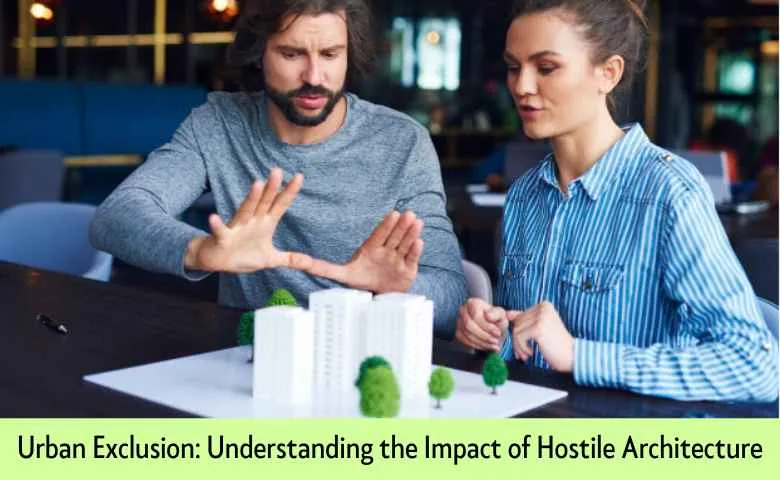Last Updated on March 19, 2024 by Admin
Public spaces are meant to be welcoming, inclusive, and accessible. They are the heart and soul of a city, offering a sense of community and a place for people to gather, relax, and enjoy their surroundings.
However, in many urban environments worldwide, an insidious form of design has taken root, which seeks to deter certain activities and individuals. This design, known as hostile architecture, has sparked controversy and raised important questions about the nature of public space, inclusivity, and social responsibility.
Table of Contents
What Is Hostile Architecture?
Hostile architecture, also referred to as defensive architecture or anti-homeless architecture, is a design approach that uses physical elements to discourage specific behaviors or demographics from using public spaces in particular ways. The primary aim is to deter activities such as sleeping, loitering, and panhandling and prevent the homeless population from finding shelter in these spaces.
Examples of hostile architecture are sloped benches (aimed to prevent people from sleeping on them), rocks in open spaces, and glass shards on top of concrete walls. Although some consider traffic calming devices part of hostile architecture because of their preventive nature, they actually aren’t. Instead of preventing certain activities, these traffic devices provide safety and encourage proper maneuvering, which, in turn, improve safety and the flow of traffic in the area where they’re installed.
Common features of hostile architecture include:
- Anti-Sleep Benches: Benches are designed with armrests or dividers in the middle to prevent individuals from lying down comfortably.
- Spikes and Sloping Surfaces: The use of spikes or uneven, sloping surfaces on ledges and surfaces to discourage sitting or sleeping.
- Uncomfortable Materials: The selection of materials that are uncomfortable to sit or lie on, such as metal or stone without cushions.
- Restrictive Landscaping: The strategic placement of plants and landscaping elements to limit the available space for certain activities.
The Controversy Surrounding Hostile Architecture
While proponents of hostile architecture argue that it helps maintain the cleanliness and orderliness of public spaces, critics view it as a form of social exclusion that targets vulnerable populations, including the homeless. The debate revolves around several key issues:
- Inclusivity vs. Exclusivity: Hostile architecture raises questions about who public spaces are designed for. Should they welcome all, or is it acceptable to create exclusionary spaces catering only to a specific demographic?
- Human Rights and Dignity: Critics argue that hostile architecture infringes on the basic human rights and dignity of individuals who may have no choice but to use public spaces for shelter.
- Addressing the Root Causes: Instead of simply deterring certain activities, some argue that addressing the root causes of homelessness and social issues is a more humane and effective approach.
- Aesthetic vs. Function: Designers often struggle to balance aesthetic considerations and functional design. Hostile architecture often prioritizes aesthetics over functionality and inclusivity.
The Impact on Vulnerable Populations
One of the most significant concerns surrounding hostile architecture is its impact on vulnerable populations, particularly the homeless. In many cities, homelessness is a complex issue with multiple contributing factors, including lack of affordable housing, mental health issues, and addiction. Hostile architecture does little to address these underlying problems and can exacerbate the suffering of those already marginalized.
For individuals experiencing homelessness, public spaces often serve as a lifeline, providing a place to rest, find shelter from the elements, and access basic amenities. When these spaces become hostile, the consequences can be dire. Homeless individuals are forced to move constantly, making it difficult to access social services, find employment, or escape the cycle of homelessness.
The Role of Public Opinion and Advocacy
Public awareness of hostile architecture has been growing, partly thanks to social media and advocacy efforts. Many cities have seen public outrage over particularly aggressive forms of defensive design. This has led to grassroots movements and advocacy groups pushing for more inclusive urban design policies.
Cities like San Francisco, Seattle, and Portland have started reconsidering their use of hostile architecture and engaged with the public to find more compassionate solutions to urban issues. This shift reflects a growing recognition that urban spaces should have a design that benefits all residents, regardless of socioeconomic status.
A Call for Inclusive Urban Design
In the battle over the design of public spaces, there is a growing call for more inclusive urban design practices. Rather than resorting to hostile architecture, many cities are exploring alternative approaches prioritizing functionality and inclusivity.
Design for All: Advocates argue that public spaces should be designed to accommodate a wide range of activities and individuals, from families enjoying a picnic to individuals seeking temporary respite.
Community Engagement: Engaging with the community to understand their needs and concerns can lead to more thoughtful and inclusive urban design solutions.
Holistic Approaches: Cities are also looking beyond design and addressing the root causes of homelessness and social issues through a combination of affordable housing initiatives, mental health support, and addiction rehabilitation programs.
Legislation and Regulation: Some cities have implemented regulations to discourage or limit the use of hostile architecture in public spaces.
Conclusion
The debate over hostile architecture in our urban landscapes underscores the fundamental question of who public spaces truly belong to. It challenges us to prioritize inclusivity, compassion, and social justice in our urban design choices. The future of our cities depends on our commitment to creating public spaces that embrace diversity, protect human dignity, and offer a sense of belonging to all members of the community.
Related Posts:
- What Is The Difference Between Civil Engineering and Architecture?
- Building Sustainable and Resilient Cities: The Importance of Urban Infrastructure Planning and Management
- The Future of Urban Planning: What Job Seekers Should Expect
- Top 10 Construction Companies in India
- How Construction Engineering is Changing the Face of Urban Development


